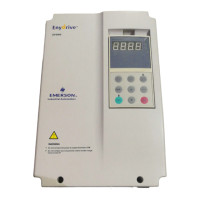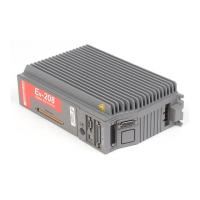Chapter 4 Operation Instructions 37
EV2000 Series Universal Variable Speed Drive User Manual
Chapter 4 Operation Instructions
4.1 Notice
In the follow-up sections, you may encounter the terms
describing the control, running and status of drive many
times. Please read this section carefully. It will help you
to understand and use the functions to be discussed
correctly.
4.1.1 The Drive’s Control Modes
It defines the physical channels by which drive receives
operating commands like START, STOP, FWD, REV,
JOG and others.
Panel control: The drive is controlled by RUN, STOP
and JOG keys on the operation panel;
Terminal control: The drive is controlled by terminals
FWD, REV and COM (2-wire mode), or by terminal Xi
(3-wire mode);
Host control: The operations such as START and STOP
can be controlled by host PC.
The control modes can be selected by parameter F0.03,
PANEL/REMOTE key and ENTER/DATA key on the
operation panel and multi-function input terminal (No.27,
28 and 29 can be selected by F7.00~F7.07).
Warning:
The user must ensure that the control mode selected is
suitable for the application. Wrong selection of control
mode may cause damage to equipment or human injury!
4.1.2 Reference Selector
In common operating modes, EV2000 has 6 possible
ways to input reference frequency, the reference
frequency can be input by:
▲ and ▼ keys on the panel;
Terminals UP/DN;
Serial port;
Analog VCI;
Analog CCI;
Pulse terminal (PULSE)
How to set Frequency
The output frequency is decided after calculating the
values from one or more of the above 6 frequency
setting methods, which involves the concept of main and
auxiliary reference frequency.
Main reference frequency: set by F0.00, multi-speed
(MS) or close loop control.
The main reference frequency is decided by the priority
of running mode. The priority level is Jog>close
loop>PLC>MS (multi-speed)>common running, e.g. if
the drive is running in MS mode, the primary reference
frequency is MS frequency.
Auxiliary reference frequency: set by F9.01~F9.04.
Preset frequency: the sum of main and auxiliary
frequency multiply a factor, which is set in F9.05 and
F9.06. Please refer to F9.05, F9.06 and Fig. 5-59 in
chapter 5.
4.1.3 Operating Status
There are 3 operating status: stopping, motor
parameters auto-tuning, and operating.
Stopping status: After the drive is switched on and
initialized, if no operating command is accepted or the
stopping command is executed, then the drive enters
stopping status.
Operating status: The drive enters operating status after
it receives the operating command.
Motor parameters auto-tuning status: If there is an
operating command after FH.09 is set to 1 or 2, the drive
then enters motor parameters auto-tuning status, and
then enters stopping status after auto-tuning process is
over.
4.1.4 Operating Modes
EV2000 has 5 kinds of operating modes which can be
sequenced according to the priority: Jog>Close loop
operation>PLC operation>Multi-step speed
operation>Simple operation, as shown in Fig. 4-1.
Jog:
When the drive is in stopping status, it will operate
according to Jog frequency after it receives the Jog
operation command(or after the JOG key is pressed).
See explanations of F3.13~F3.16 for details.
Close-loop operation:
If the close-loop operating function is enabled(F5.00=1),
the drive will select the close-loop operation mode, that
is, it will perform PI regulation according to the reference
and feedback values (See explanations of Parameter

